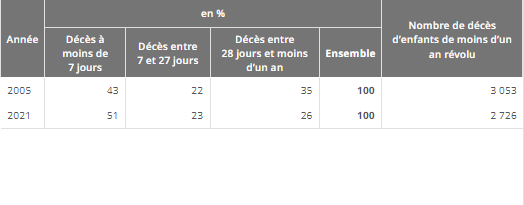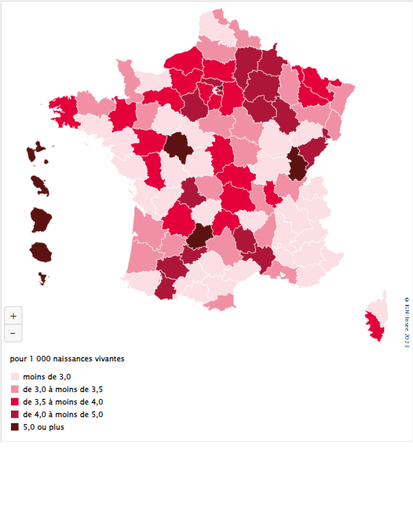Since 2015, infant mortality in France has been higher than the European average: 3.7 deaths per 1,000 births, compared to 3.3 for Europe. A figure on the rise in France. This gap is particularly felt in the most isolated regions of our territory. Explanations.
France is ranked 20th among the countries with the lowest infant mortality. In 2021, there were 2,700 deaths among children under one year of age, i.e. 3.7 infant deaths per 1,000 live births, according to a study by INSEE (National Institute of Statistics and Studies economic). Before 2005, this rate had fallen drastically thanks to advances in medicine and the improvement in the quality of life of the French. But since then it hasn’t dropped. It even increased by 7% between 2012 and 2019, peaking at 3.9 deaths per 1,000 births in 2017.
Half of deaths occur before the first week
The vast majority of deaths recorded in the INSEE study occur during the first days of the infant. The statistical institute notes that nearly half of infant deaths are declared less than a week after birth; and that a quarter of them take place between 7 and 28 days. Early neonatal mortality (before 7 days) seems to increase over time: it was 65% in 2005 against 74% in 2021.

Distribution of deaths occurring before one year according to lifespan
On the other hand, post-neonatal mortality (between 28 days and 1 year) continues to decrease. In 2005, it rose to a rate of 35%, while it was 26% in 2021.
Several factors involved
An Inserm study published in March 2022 in the scientific journal The Lancet corroborates the results and interpretations of INSEE on the potential causes of the increase in infant mortality in France.
In recent years, advances in medicine have allowed more very premature babies to be born alive. Counted in live births, a certain number of these premature babies are now more often able to survive a few hours or a few days after birth before dying.
Another DREES study cited by INSEE underlines in parallel “a significant increase in the number of women who decide to continue their pregnancy despite knowledge of serious pathologies of the fetus“.
“The main risk factors for death before 7 days include: state of health at birth (prematurity, congenital anomalies), maternal health and socio-economic factors of the family”, details the Inserm study. . However, “the proportion of mothers over 35 years old increased from 12.5% to 21.3% between 1995 and 2016 and the proportion of obese women increased from 7.5% to 11.8% between 2003 and 2016 “, according to the study. Two factors likely to cause more early infant deaths.
Moreover, even if pregnant women smoke less than before, their number remains high in France according to INSEE. The study also shows that the share of homeless women giving birth is increasing.
Occitanie departments above average
Several departments of Occitania are above the national average (3.7) with regard to infant mortality. The Lot has 5.1 deaths per 1000 births. Its neighbor Gers is tied with Lozère: 4.6 infant deaths per 1000 births. Far behind, Aude records a figure of 1.4 deaths per 1000 births.

Infant mortality rate per 1,000 live births by mother’s department of residence over the period 2019-2021
But how can these disparities in the Occitanie region be explained? THE medical deserts faced by the region would be one of the reasons for these higher mortality rates. Due to the distance from medical services, monitoring of the pregnancy may prove to be too partial and difficulties in accessing obstetric services may be encountered.
Gers, Lozère and Lot are the only departments in Occitanie to have a single maternity hospital. A situation that is not about to get better in view of the report of the Academy of Medicine which recommends the closure of 21 establishments in the region including that of Gers, Lot and Lozère.

